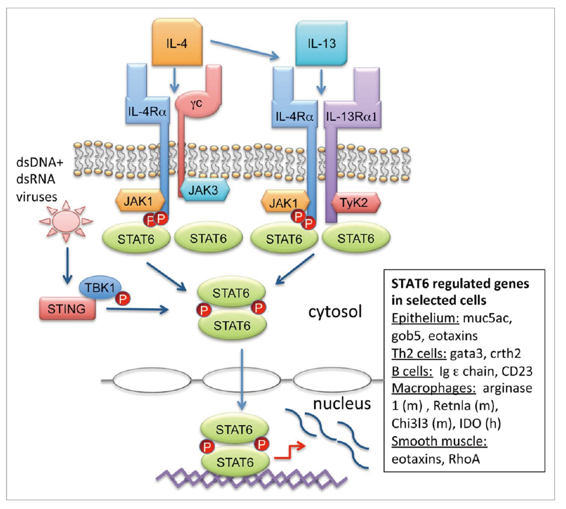
Our promise to you:
Guaranteed product quality, expert customer support.
 24x7 CUSTOMER SERVICE
24x7 CUSTOMER SERVICE
 CONTACT US TO ORDER
CONTACT US TO ORDER
STAT6 Gene Editing 
Proteins belonging to the STAT family mediate transmission of signals of numerous cytokines and growth factors from the cell membrane to the nucleus through the classical JAK-STAT pathway. Malfunctions in this pathway are known to cause immune system disorders and cancers. Thus, the JAK-STAT pathway is considered to be of great importance in the development of therapeutic interventions. STAT6, an important member of the STAT family, plays an important role in the differentiation of Th2 cells and has been implicated in the development of asthma.
Ligation of cytokines interleukin-4 (IL-4) and interleukin-13 (IL-13) with their receptor IL-4Rα result in a common STAT6-mediated signaling pathway crucial to the development of Th2 inflammation characteristic of asthma and anti-parasitic responses. When phosphorylated, STAT6 is transported to the nucleus where it regulates gene expression in multiple cell types critical to the balance between host immune defense and allergic inflammatory responses.
STAT6 in Human Lung Disease
One of the most important results in our study is that IL-4/STAT6 pathway-specific inhibitor can reduce the number of total cells, neutrophils, eosinophils as well as lymphocytes, which have indicated the inhibition of IL-4/STAT6 pathway may alleviate bronchial asthma and airway inflammation. As a key factor responsible for inducing cathepsin activity in macrophages in vivo and in vitro, STAT-6 was significant for the progression of mucus generation along with airway inflammation in animal models of allergic airways disease, and both IL-4 and IL-13 activate signal transducer, sharing IL-4Rα subunit in the cognate receptors, are activators of STAT-6. One study suggested that at least partially, the down-regulation of GATA-3 and STAT-6 can attenuate the immunomodulatory actions resulted from Th1/Th2 cytokines in asthma. Up to now, it was complicated to develop novel and effective anti-inflammatory methods for asthma treatment, but maybe a much better understanding of the inflammatory signaling pathways demonstrated in asthmatic airway cells might lead to more effective therapy classes in the future. Therefore, more prospective studies with larger sample sizes should be conducted to provide more precise estimates to confirm the effects of IL-4/STAT6 pathways, thereby providing new therapeutic strategies for the treatment of bronchial asthma and relieving airway inflammation.
 Figure 1. STAT6 signaling results in distinct gene profiles in different lung cell types. (Walford H H, et al. 2013)
Figure 1. STAT6 signaling results in distinct gene profiles in different lung cell types. (Walford H H, et al. 2013)
STAT6 as a promising target for PKD therapy
The autosomal dominant form of polycystic kidney disease (ADPKD) is one of the most frequent monogenic disorders and the most frequent among inherited kidney disorders. Several effects of STAT6 activation in tubular epithelial cells could play a role in PKD including the immune system and fibrosis. Fibrosis is a major contributing factor to the severity of disease in ADPKD. Periostin is overexpressed in ADPKD and was found to stimulate the proliferation of cystic epithelial cells via its receptor αv-integrin. Therefore, periostin may contribute to renal cyst growth in an auto/paracrine fashion as a mitogen downstream of STAT6. Components of the immune system that may be involved in STAT6-mediated effects on renal cyst growth are macrophages that have recently been proven to be a significant factor in PKD. It is plausible that IL4/13 secreted by these renal M2 macrophages leads to aberrant STAT6 activation of tubule epithelial cells—at least as an initiating or sustaining event—and promotes their proliferation and cyst growth. Recently, the study has indicated that aberrantly increased STAT6 activity, through IL-13 signaling, in PKD results in strong overexpression of four proteins: IL-24, periostin, galectin-3, and the pIgR. These proteins are overexpressed in polycystic kidneys caused by a wide variety of genetic defects, showing that IL-13 signaling, and subsequent STAT6 activation, may orchestrate a coordinated expression of a set of genes as a general feature accompanying renal cyst growth. Thus, the IL-13/STAT6 signaling pathway is a promising target for PKD therapy, especially as inhibitory compounds are already being developed for the treatment of asthma.
STAT6 Gene Editing Service
CRISPR/Cas9 PlatformCB, a global leading biotechnological company specializing in gene editing, is dedicated to offering comprehensive CRISPR/Cas9 gene editing services and products for academic research, biotech research and pharmaceutical drug discovery. With deep gene editing knowledge and extensive experience in experimental operation and data processing, we help you effectively control STAT6 genes knockout/knockin/point mutation in cells or animals via CRISPR/Cas9 technology.
| Service | Details | Alternative cell lines or animal species |
| STAT6 Gene Editing Cell Line Generation |
| HEK239T, Hela, HepG2, U87, Ba/F3, CHO, MDA-MB-453, MDA-MB-231NIH3T3, T47D, Neuro2a, MCF7, RKO, K562, RAW264.7, etc. |
| STAT6 Gene Editing Animal Model Generation |
| Mouse, rat, rabbit, zebrafish, C. elegans, etc. |
Related Products at CRISPR/Cas9 PlatformCB
| CATALOG NO. | PRODUCT NAME | PRODUCT TYPE | INQUIRY |
| CCKM0857 | B6J-Stat6em1Cd1169 | Knockout Mice | Inquiry |
| CDKM-0930 | B6J-Stat6em1Cflox | Knockout Mice | Inquiry |
| CLKO-0569 | STAT6 KO Cell Lysate-HeLa | Knockout Cell Lysate | Inquiry |
| CSC-RT1079 | Human STAT6 Knockout Cell Line-HeLa | Knockout Cell Line | Inquiry |
References
- Liu Y, et al. IL-4R suppresses airway inflammation in bronchial asthma by inhibiting the IL-4/STAT6 pathway. Pulmonary pharmacology & therapeutics, 2017, 43: 32-38.
- Li J, et al. Structural basis for DNA recognition by STAT6. Proceedings of the National Academy of Sciences, 2016, 113(46): 13015-13020.
- Walford H H, Doherty T A. STAT6 and lung inflammation. Jak-stat, 2013, 2(4): e25301.
- Olsan E E, et al. Identification of targets of IL-13 and STAT6 signaling in polycystic kidney disease. American Journal of Physiology-Renal Physiology, 2018, 315(1): F86-F96.
- Weimbs T, et al. Regulation of STATs by polycystin-1 and their role in polycystic kidney disease. Jak-Stat, 2013, 2(2): e23650.